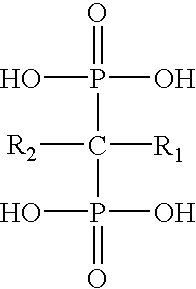Uses of 1-amino-3-(N,N-dimethylamino)-propylidene-1,1-bisphosphonic acid
a technology of dimethylamino and dimethylamino acids, which is applied in the direction of phosphorous compound active ingredients, nitro compound active ingredients, metabolic disorders, etc., can solve the problems of marked reduction of anti-resorptive activity, and achieve healthy bone structure, prevent and remove unfit mineralized structures in the bon
- Summary
- Abstract
- Description
- Claims
- Application Information
AI Technical Summary
Benefits of technology
Problems solved by technology
Method used
Image
Examples
example 1
Bisphosphonates (BP) have the following general structure: ##STR1##
wherein R.sub.1 - and R.sub.2 -chains can have various identities. The structures of the R1 and R2 chains of the bisphosphonates used in this study are shown in FIG. 1. All of them were from Gador S.A. (Buenos Aires, Argentina). Fura-2 / pentaacetoxymethyl ester (Fura-2 / AM), pluronic F-127, nifedipine, verapamil, neomycin, Dulbecco's modified Eagle's medium and fetal bovine serum were from Sigma Chemical Co. (St.Louis, Mo., USA). U73122 (1-(6-((17.beta.-3-methoxyestra-1,3,5(10)-trien-17-yl)amino)hexyl)-1H-pyrrole-2,5-dione) and U73343 (1-(6-((17.beta.-3-methoxyestra-1,3,5(10)-trien-17-yl)amino)hexyl)-2,5-pyrrolidine) were from Biomol Research Laboratories Inc. (Plymouth Meeting, Pa., USA). All other reagents used were of analytical grade.
example 2
Cell Culture
Osteoblast-like rat osteosarcoma cells (ROS17 / 2.8) were cultured as monolayers at 37.degree. C. in Dulbecco's modified Eagle's medium (DME) containing 10% fetal bovine serum under humidified air (5.5% CO.sub.2). After 48 hours, medium was changed to DME containing 1% fetal bovine serum. Unless otherwise stated, cells were allowed to grow until confluence (4-5 days after plating).
example 3
Intracellular Calcium Measurements
Intracellular Ca.sup.2+ changes were monitored by using the Ca.sup.2+ -sensitive fluorescent dye Fura-2 as previously described (Vasquez et al., 1998, J. Biol. Chem. 273, 33954-33960). Cell dye loading was achieved by incubating the cells in buffer A containing (in mM): 138 NaCl, 5 KCl, 1 MgCl.sub.2, 5 glucose, 10 HEPES (pH 7.4), 1.5 CaCl.sub.2, plus 0.1% bovine serumalbumin (BSA), 2 .mu.M of the pentaacetoxymethylester derivative (membrane permeable) Fura-2 / AM and 0.012% pluronic F-127, in the dark during 40 min at room temperature (20-25.degree. C.) in order to minimize dye compartmentalization. Unloaded dye was washed out and cells were stored in buffer B (buffer A without BSA, Fura-2 / AM and pluronic F-127) in the dark (room temperature) by at least 30 min prior to use, to allow for complete intracellular dye deesterification. For fluorescence measurements the coverslips containing dye-loaded cells were mounted into quartz cuvettes and introduced...
PUM
| Property | Measurement | Unit |
|---|---|---|
| Molar density | aaaaa | aaaaa |
| Molar density | aaaaa | aaaaa |
| Fraction | aaaaa | aaaaa |
Abstract
Description
Claims
Application Information
 Login to View More
Login to View More - R&D
- Intellectual Property
- Life Sciences
- Materials
- Tech Scout
- Unparalleled Data Quality
- Higher Quality Content
- 60% Fewer Hallucinations
Browse by: Latest US Patents, China's latest patents, Technical Efficacy Thesaurus, Application Domain, Technology Topic, Popular Technical Reports.
© 2025 PatSnap. All rights reserved.Legal|Privacy policy|Modern Slavery Act Transparency Statement|Sitemap|About US| Contact US: help@patsnap.com



